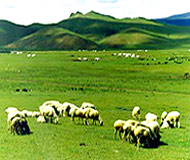 China’s meteorological departments have discovered, using remote-sensing satellite technologies, dozens of new oases in the desert areas of the western region of the country in recent years.
China’s meteorological departments have discovered, using remote-sensing satellite technologies, dozens of new oases in the desert areas of the western region of the country in recent years.
On-the-spot investigations have discovered that the oases are actually industrial bases built by Chinese enterprises, sources said.
An oasis named Engebei in the Hobq Desert in the Inner Mongolia Autonomous Region, north China, is one of them.
Engebei was a piece of desert 10 years ago. The Erdos Group, a cashmere sweater maker based in Inner Mongolia, bought this 20,000 hectares of sandy land in 1989 and planned to plant grass for grazing goats.
Five years later, Wang Minghai, vice-president of the group, contracted the project. He invested some 10 million yuan (US$1.2 million) to build lakes, plant trees and grass in the following years.
As a result, the forest coverage in Engebei has increased to the current over 90 percent from the former 5 percent. Now, Wang can earn nearly 1 million yuan annually by developing tourism, grazing ostriches, peacocks, turkeys and goats and planting medicinal herbs and fruits.
Well-known Chinese scientist Qian Xuesen first initiated the theory of developing industries in the desert more than a decade ago.
According to Qian's theory, efforts are encouraged to develop the desert and sandy areas by making full use of local natural resources and modern science and technology, for the purposes of making big profits and harvesting grain, cotton, oil, meat, eggs and milk in the desert.
"Abundant sunshine and heat resources, a pollution-free environment and cheap land are all favorable aspects of business in the desert," said Wang Minghai, adding, "it's not easy to make money here. But you don't need to worry about going bankrupt, because turning the desert green will ensure success of growing plants and raising animals."
China has eight deserts which are all located in the western region. The desert area now totals 2.6 million square kilometers, or more than 20 percent of the country's total land area. The economic losses caused by sandstorm disasters exceed 8 billion yuan each year.
To curb and prevent the expansion of deserts, China has adopted a series of laws and regulations such as a draft law on desertification prevention and treatment, a program on the construction of desertification prevention and treatment projects in key areas, and a program on implementation of the UN Convention on Desertification Prevention.
In recent years, the Chinese government has also worked out policies encouraging individuals and enterprises to participate in the harnessing of barren hills and deserts. Under the new policies, participants enjoy the preferential treatment of making their own profits and enjoying supporting funds and low-interest loans provided by the government.
Statistics released by the Chinese forestry administration show that at present, hundreds of Chinese enterprises are engaged in desert prevention and treatment and ecological improvement in the western region. More than 30 enterprises are working in the Ulan Buh Desert in Inner Mongolia.
The Pangu Group, the biggest private enterprise in Inner Mongolia, started building an agriculture and forestry development zone in the Ulan Buh Desert in 1997. To date, the group has tackled more than 60,000 hectares of desert and is making a profit.
Vice-President Pan Zhaodong said, "Our target is to invest 1 billion yuan (US$120 million) in the desert and make a profit of 1 billion yuan." The group plans to plant fast-growing poplar trees to serve the purpose of paper-making and plant medicinal herbs to produce bio-medicines.
Opposite Pangu's agriculture and forestry development zone is a piece of desert being developed by the Beijing Science Development Co., Ltd. The company fenced off desert to plant trees and has built up plastic shelters for growing organic vegetables. Its products, such as small pumpkins, are selling well overseas.
The involvement of enterprises in desert prevention and treatment, which has become popular in most parts of western China, is also bringing profit to local farmers and herdsmen.
"I wanted to move several times in the past because I was poor. Now, I have a bank deposit of more than 50,000 yuan," said Batar, a herdsman who works at the Pangu Group's production base in the Ulan Buh Desert. "What makes me happier is that green has returned to my hometown and we are no longer afraid of strong winds and sandstorms," he added.
"Our purpose is to improve the ecology in desert areas," said Pan Zhaodong of the Pangu Group.
China's efforts to prevent and control desertification has also won support of foreign enterprises.
The Unilever Co. plans to invest 35 million yuan in five years to help plant trees in areas where desertification is serious, such as Inner Mongolia, Qinghai, Sichuan and other places in China. The Lee Foundation of Singapore donated HK$1 million to China's afforestation drive in desertification-ridden Huailai County, in north China's Hebei Province.
Recently, a group of private entrepreneurs in Inner Mongolia put forward a proposal calling on more people in non-governmental sectors to actively join the efforts to develop industries in the deserts, which, they say, is both beneficial to the country and the investors.
(Xinhua 06/08/2001)
